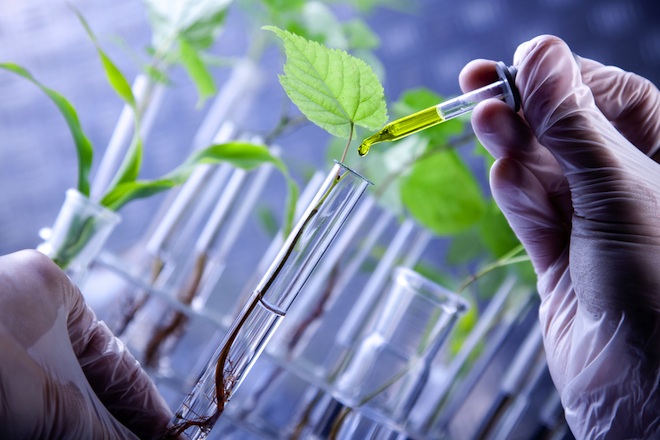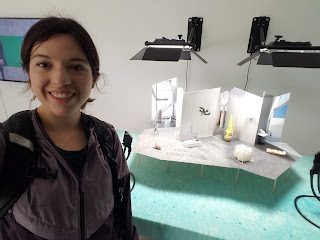Unit 6: BioTech + Art
The concept of allowing an artist into a science lab is a hard pill to swallow (pun intended). One quickly conjures concerns for safety, professionalism, and ethics. Nonetheless, driven artists such as Eduardo Kac have entered the lab, unlimited by societal standards. Kac decided to perform transgenic experiments on an albino bunny by adding fluorescent genes, extracted from a jellyfish, to its fertilized cell (Vesna, Lecture 1). Controversy sparked immediately among animal activists who claimed the experiments were unnecessary and abusive towards animals. In his TED Talk that discusses his art endeavors, Kac argues that humans are innately transgenic and he as an artist is actually helping the public see the potential in creating new forms of life (Kac).
Of course, with these new inventions come new questions: What if a species was inadvertently released into the wild and free to breed and pass down its transgenic self or what kinds of evil can surface with the power to breed theoretically anything? (Levy). It is no surprise that experimenting with life has been of great interest to artists, engineers, researchers, and laymen alike. "Creativity breeds creativity [and] the more innovation there is, the more innovation there is" (Outlaws Symposium). The power to do so, however, must be discussed and not just any experiment ought to be allowed. It is important to note that artists are experimenters as much as scientists, and any their work does take an effect on society. Experiments performed by artist Kathy High are especially significant, as she attempts to uproot truth behind animals (Vesna, Lecture 3). Can animals have empathy and how valuable are their lives in comparison to us humans? Finally, why is it that humans are the species that strive to make, modify, and control life?
Reading through the relationship between biotech and art, I was surprised to find a personal connection as well. Growing up, my mom would love to take me to plant nurseries. Little did I know, that most of the plants in my own backyard turned out to be genetically-modified! Additionally, many foods that we eat undergo similar processes to grow attractively. Despite much controversy against artistic play with biology, there is some appreciation, wonder, and mystery behind altered life.
Sources
Carey, Benedict. “In Rat Experiment, New Hope for Spine Injuries.” The New York Times, The New York Times, 31 May 2012, www.nytimes.com/2012/06/01/health/in-rat-experiment-new-hope-for-spine-injuries.html.
Coste. “Zoom : Rencontre Avec Le Bio-Artiste Eduardo Kac.” Pinterest, 1 June 2007, www.pinterest.com/pin/400398223095556506/.
Laylin, Tafline. “Israel's Genetically Modified ‘Superplants’ Thrive in Arid Areas.” Green Prophet, 1 Sept. 2013, www.greenprophet.com/2013/09/israels-genetically-modified-superplants/.
Levy, Ellen. "Defining Life: Aritsts Challenge Conventional Classifications. 2003. 1-17. Print.
Outlaws Symposium, "Meanings of Participation:Outlaw Biology? Outlaws, Hackers, Victorian Gentlemen." 1-8. Print.
TEDx Talks. YouTube, 1 Dec. 2015, www.youtube.com/watch?time_continue=1095&v=IS_5WJteCC8.
Vesna, Victoria. “BioTech + Art.” Lecture 1. <https://cole2.uconline.edu/courses/888567/pages/unit-6-view?module_item_id=16300814>.
Vesna, Victoria. “BioTech + Art.” Lecture 3. <https://cole2.uconline.edu/courses/888567/pages/unit-6-view?module_item_id=16300814>.
 |
| The GFP Bunny |
Of course, with these new inventions come new questions: What if a species was inadvertently released into the wild and free to breed and pass down its transgenic self or what kinds of evil can surface with the power to breed theoretically anything? (Levy). It is no surprise that experimenting with life has been of great interest to artists, engineers, researchers, and laymen alike. "Creativity breeds creativity [and] the more innovation there is, the more innovation there is" (Outlaws Symposium). The power to do so, however, must be discussed and not just any experiment ought to be allowed. It is important to note that artists are experimenters as much as scientists, and any their work does take an effect on society. Experiments performed by artist Kathy High are especially significant, as she attempts to uproot truth behind animals (Vesna, Lecture 3). Can animals have empathy and how valuable are their lives in comparison to us humans? Finally, why is it that humans are the species that strive to make, modify, and control life?
 |
| Experimentation of Rats |
Reading through the relationship between biotech and art, I was surprised to find a personal connection as well. Growing up, my mom would love to take me to plant nurseries. Little did I know, that most of the plants in my own backyard turned out to be genetically-modified! Additionally, many foods that we eat undergo similar processes to grow attractively. Despite much controversy against artistic play with biology, there is some appreciation, wonder, and mystery behind altered life.
 |
| Genetic Modification of Plants |
Sources
Carey, Benedict. “In Rat Experiment, New Hope for Spine Injuries.” The New York Times, The New York Times, 31 May 2012, www.nytimes.com/2012/06/01/health/in-rat-experiment-new-hope-for-spine-injuries.html.
Coste. “Zoom : Rencontre Avec Le Bio-Artiste Eduardo Kac.” Pinterest, 1 June 2007, www.pinterest.com/pin/400398223095556506/.
Laylin, Tafline. “Israel's Genetically Modified ‘Superplants’ Thrive in Arid Areas.” Green Prophet, 1 Sept. 2013, www.greenprophet.com/2013/09/israels-genetically-modified-superplants/.
Levy, Ellen. "Defining Life: Aritsts Challenge Conventional Classifications. 2003. 1-17. Print.
Outlaws Symposium, "Meanings of Participation:Outlaw Biology? Outlaws, Hackers, Victorian Gentlemen." 1-8. Print.
TEDx Talks. YouTube, 1 Dec. 2015, www.youtube.com/watch?time_continue=1095&v=IS_5WJteCC8.
Vesna, Victoria. “BioTech + Art.” Lecture 1. <https://cole2.uconline.edu/courses/888567/pages/unit-6-view?module_item_id=16300814>.
Vesna, Victoria. “BioTech + Art.” Lecture 3. <https://cole2.uconline.edu/courses/888567/pages/unit-6-view?module_item_id=16300814>.


Hi Joslyn, I really enjoyed reading your blog. After watching the lecture videos, I found myself to have similar questions to yours about "can animal have sympathy..." and about humans being the species that want to control life. Ultimately, these questions really focus on the purpose and ethics of science and the advancement/direction of science and how those may be important to consider in bioart. Although bioart is representative of human's creativity, I believe that bioartists need to follow uphold bioethics as well in order to show respect/appreciation for the organisms that they use in their artworks.
ReplyDeleteI also found Kac's work with the transgenic bunny really interesting, and like how you connected his work and controversy over what he did to questions posed by Levy about passing down these transgenic traits and the possibilities this might open the door to.
ReplyDelete